Positioning for the serve return should take the following points into consideration:
– how fast the server hits the serve
– the type of spin the server uses
– the angles the server prefers
– whether the returner favors one side over another.
These observations should be made in cooperation with your partner during the warm-up and first games. Observing your opponents' tendencies is crucial in planning your tactics.
Knowing these, we’ll take a look at the following positions:
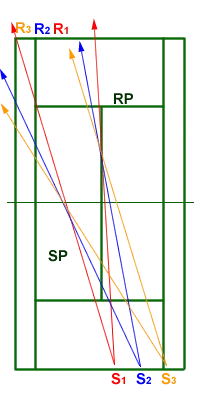
1. In the Middle of the Possible Angles
The returner should position himself to cover any possible angles the server can deliver the ball (see the graphic above).
As you see in the graphic, the wider the server positions himself to serve, the wider the receiver should be set up.
Also, if the server is close to the baseline center then the receiver should be about halfway between the baseline center and the doubles sideline. If the server is closer to the singles sideline then the receiver is behind the alley, etc.
It’s very important to consider that the receiver should not be facing the net, instead, he should be squared to face the server, adopting a low stance that makes it possible for him to “spring” in any direction.
2. Favouring the Weak Side
Everybody has a strong side that they want to use to their advantage. You should not be stubborn in using your weakness when you can actually run around it and utilize your strength… So it is okay to stand a little towards the left to set up your forehand (if this is your stronger stroke). Just make sure you are quick to react to cover the obvious opening.
3. The Depth Factor
How far you stand to receive the incoming serve is also important.
From personal experience, I sometimes enjoy challenging my opponents by positioning myself very close to the service line to receive serve (see the graphic below).
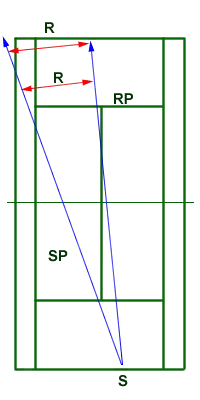
The server will be pressured seeing the returner so close to the net. His choices are: either “teach me a lesson” by hitting the ball very hard (which could result in a netted serve / or deep) or hit a slower serve with extra spin which he knows I’ll attack (that makes him realize that he has to react very quickly right after delivering the serve). Both situations constitute extra pressure for the server.
It is a risky tactic for the receiver considering he may have to return a hard serve that goes in. If that is the case, his plan should be to just block the ball by adjusting his backswing and reacting very quickly.
By standing closer to the service line, the receiver closes the server’s angles but he sacrifices the time to prepare (which is shorter in this case).
– On the other hand, standing far behind the baseline gives you more time to prepare for the serve, but the server has a wide open space to hit the ball to for an ace or just to make you hit the ball on the run.
When should you stand closer and when should you stand farther back to receive the serve?
– if the server has a very powerful and deep flat serve, a smart choice would be to stand farther back (how far… you will have to decide yourself); that should be done mostly on first serves;
– if the server prefers to hit with a lot of spin (e.g. slice wide that pulls the receiver off the court) then it would be wise to stay closer to the service line to cut the angle
Important: To control a ball coming with a lot of spin make sure you don’t block it. Your racquet would act like a wall which allows the ball to rebound in the direction of the spin. Instead, attack the ball aggressively to counteract the spin.
– in returning the second serve the player should stand closer to the service line to attack the weaker serve; a good tactic would be to hit the ball to the opposing net player occasionally since he will have a shorter time to react to it. (see Server Return Placement section)
4. Reading the Spin
It’s very important to determine the type of spin the server will use to deliver the ball. If you notice the player tossing the ball slightly to his right then get ready to react wide to a slice. If the ball is tossed more over the server’s left shoulder then expect a kick serve. The delivery might be a powerful flat serve with the toss far in front.
Of course, some players are very good at disguising their serve delivery but it is to your advantage to pay attention and read these clues.
5. Ultimately, the receiver can position himself anywhere he wants as long as he does not hinder his partner or affect the quality of his return. He can even position himself inside the service court, if he wants, as long as he does not get hit by the ball (obviously, it is not recommended). By the way, the only thing that should touch the ball is the racquet; anything else would result in a lost point, also the ball must bounce before being returned – so volleying the serve return is not allowed.
So be creative with the court positioning, try and learn as you go, and figure out what works and what doesn’t until you find the right tactic to use to your advantage.
-------------------------
Depending on the server’s delivery aspects (speed, depth, spin, placement) and the returner’s physical (speed, control, quickness, etc.) and technical (weak backhand / strong forehand, etc.) capabilities, the placement on the return of serve can be as follows:
1. cross-court deep
2. cross-court short
3. down the center
4. at the net player
5. drop shot cross-court
6. down the alley
7. down the line deep (lob over opposing net player).
Let’s analyze each one of them:
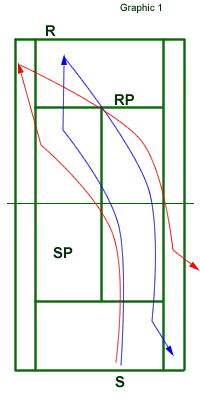
1. Cross-court deep (see graphic 1, above)
This is the classical return used most often, especially against a team in the one-up-one-back formation. The goal is to keep the ball away from the net player and also to pin the server in the backcourt.
Execution: Topspin and slice groundstrokes can both be used to deliver the ball deep as long as it has enough speed and distance to avoid an interception by the opposing net player.
This type of shot is much easier to execute if the serve was delivered toward the middle of the service box or wide (close to the sideline). Harder to hit deep cross-court if the serve was delivered closer to the center service line (T) considering that the returner’s partner’s position can affect the path of the ball.
2. Cross-court short (see graphic 1, above)
An easy target to achieve if the serve is short or deep wide (close to the sideline), returner hitting the outside part of the ball. The ball travels away from the opposing net player and gets the server off the court.
Special attention must be accorded by the returner’s net partner who will also have to move wide to cover his alley once this type of return has been made.
Execution: Heavy topspin groundstrokes are ideal for this kind of shot (a slice would send the ball too wide).
3. Down the center (see graphic 2, below)
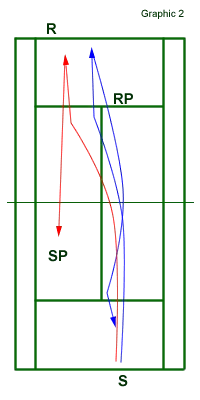
This is an option that the receiver has when the serve has been delivered down-the-T.
If both teams start in a one-up-one-back formation, considering that the receiver’s partner is close to the net and the opposing net player can cover any down-the-line angles, hitting the ball down the center is one choice the receiver has, the other being to lob the net player.
That, of course, sets up the opposing net player for a poach.
Execution: – heavy topspin short and low towards the center line. This way, if the opposing net player tries to poach, the low ball will be hard to put away and control.
4. At the net player (see graphic 2, above)
This is a tactic that should be used in the first games to test the opposing net players’ skills. Take notes of how comfortable the opposing players are at the net.
It is legal to hit the ball hard to the net player as long as you don’t have the intent to injure him.
Get ready for anything to happen: from the net player being ready and hitting an aggressive volley, to a weak sitter which you can attack to put away.
5. Drop shot cross-court (see graphic 3, below)
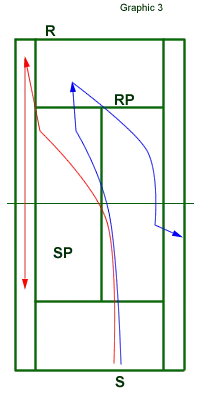
The drop shot on the return of serve is one of those strokes that requires very good skills (soft hands, good touch, and control).
A risky shot to use considering that if it is reached by the opposing players in time can be very damaging for your team.
Execution: The obvious under-spin has to be imparted and the ball should land wide enough so that the opposing net player should have a hard time reaching it and also short enough to keep the baseline player from getting to it and hitting a put away.
Disguising it is key followed by flawless execution. This should be used only when you can afford to take a risk (e.g. 0-40, 15-40), and the returner must move up to the net to close the angles just in case the opponents get to it.
Expect either an angled short shot or a lob, depending on whether the opponents get to it late or not. In fact, if the drop shot was poorly executed and the opposing players get to it early, the receiving team is in danger of defending against an aggressive put-away groundstroke.
So, the drop shot on the return of serve should be used with caution and only in certain situations.
6. Down the alley (see graphic 3)
Return the serve down the alley when the serve was delivered wide (close to the sideline).
If the server’s net partner fails to cover the alley, then that’s the time to pass the net player down the alley. You must be aware though that the execution implies hitting the ball over the high part of the net and the court is shorter down the line. Heavy aggressive topspin should be used to execute the shot successfully.
7. Lob over the opposing net player
Getting lobbed is the most feared situation by recreational players for obvious reasons (timing to execute an overhead, fear of embarrassment if they miss the overhead, movement, etc.). That’s the reason why this return tactic should be used often.
It can be executed from any position regardless of where the ball lands in the service court. It is quite easy to do considering that all it takes is a little opening of the racquet face.
Tactically, it can be very efficient considering that the opposing team, if lobbed, must switch positions on the court and change their initial formation.
A successful lob must be followed to the net (giving the serve returner plenty of time to move up). Consider that most of the time, the defending team will throw a lob back.
The serve returner right after hitting the lob should move up but stops just inside the service line, and he does that for the following reasons:
a). the reply from the opponents could be a deep lob (which he can cover if it goes over his partner’s head);
b). if the reply is a short lob, then he can attack and put it away;
c). if the opponents choose to respond with an aggressive groundstroke down the middle, then the serve returner can back up his partner if he has a hard time returning the ball.
Trivia: Do you know the one shot that it is almost impossible to execute a lob off of?
Answer: Heavy and low slice (serve or groundstroke). A ball hit with slice stays low, making it very difficult for the player to get under the ball and hit up.
In conclusion, learn the tactics from this serve return analysis and you will be getting an edge over the server and break the serving team more often.
-----------------------
The best teams in doubles are the ones that are comfortable playing at the net. Obviously, they will not hesitate to move up on any shot and finish the point up.
So what can you do when the server keeps coming up to the net behind every serve?
– Hit the ball with topspin, cross-court, aiming for the service line with a medium pace. That makes the ball land down at the feet of the server (who is coming up behind his serve).
The low ball will make the attacking server hit it up. Your net partner can then attack and put away this “pop-up”.
– You can also lob the return over the server’s net partner. Just make sure that it lands deep to the baseline, otherwise, the attacking team will love to hit the overhead (they are usually very good at this kind of shot).